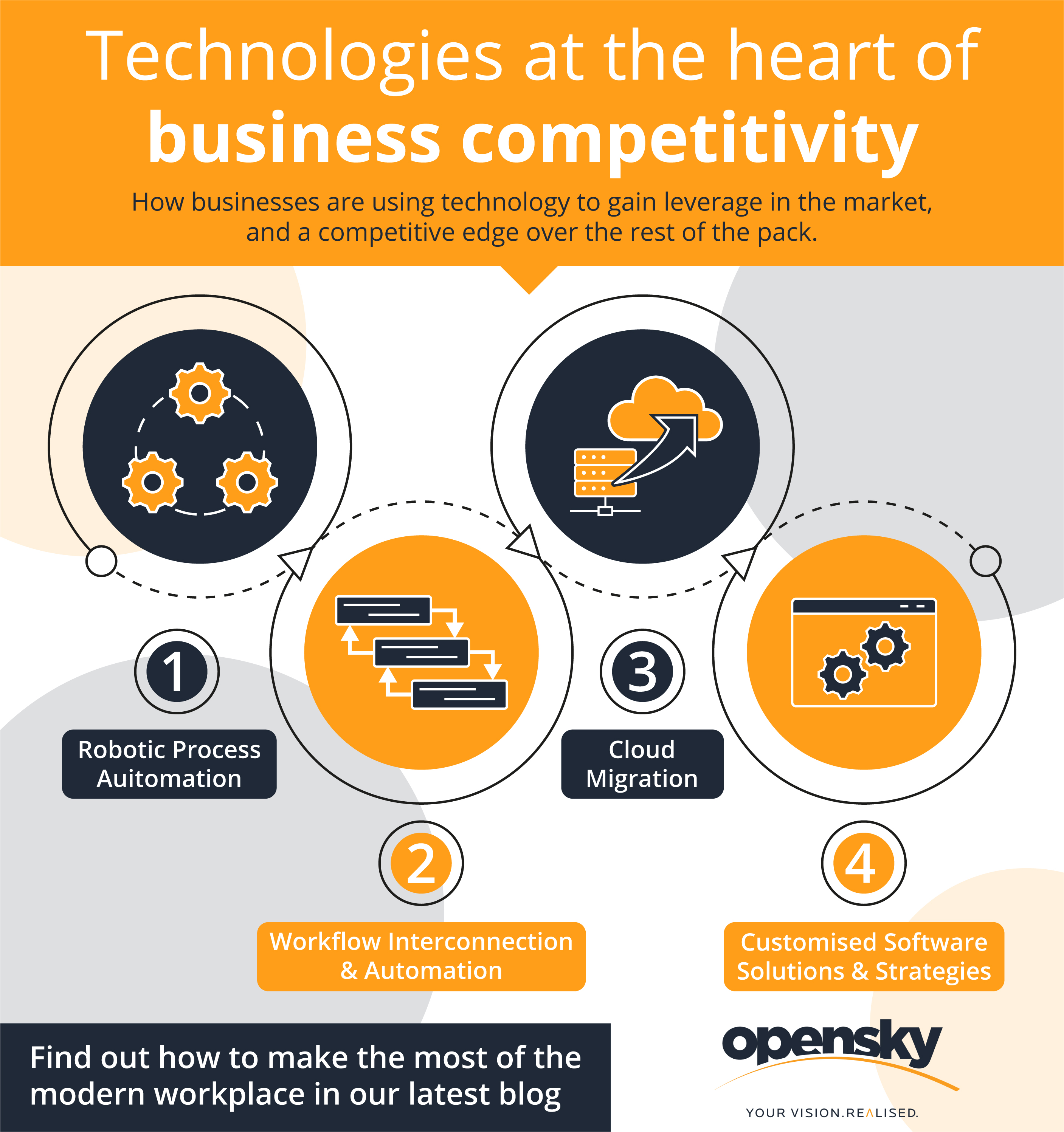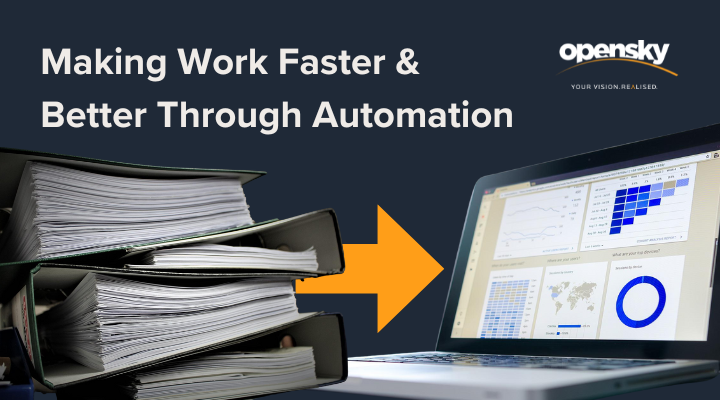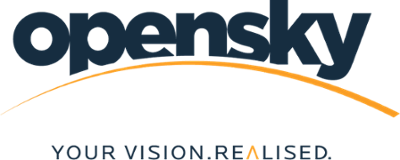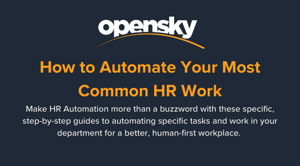Technologies and Tools at the Heart of Business Competitivity in 2022
In 2022, modern businesses are under more pressure than ever to be leaner, more competitive, and more efficient, so that they can stay ahead of the pack. A host of emergent digital tools and technologies are a vital part of how they do this. In this blog, we'll take a look at the 4 cornerstones of tech that are letting them stay optimised, cost-effective, and ahead of the curve.
Technology is at the heart of all business. As it evolves so does business, and never has this been more true than in the post-pandemic world.
Just as digitisation, remote work, and online services & stores were key survival tools that allowed businesses to stay operational during the darkest parts of the global shutdown, so too are a new wave of tools and technologies allowing modern digital-first businesses to carve out a secure space for themselves in the 21st century digital economy

What is the digital-first economy, anyway?
Over the past nearly three years, we've seen the dominance of digital tools taking over the heart of business, with online shops, digital platforms, remote & hybrid work, e-services, e-ecommerce-first models, and more. With people staying in, working from their spare room, buying things online, and seeking digital means of work, entertainment, and information over physical ones, the design of our economies has fundamentally shifted from a 'brick and mortar first, digital service is a bonus' setup, to one where every organisation is defined by their digital strategy and presence.
In fact, contrary to some popular thinking, the spread of these digital technologies and tools across the entirety of the services & business spectrum during the pandemic doesn't mean that the digital economy will slow down or digitisation will reach a plateau now that "we're all online and connected and working/shopping/living from home". Rather to the contrary, a greater level of digitisation and even more rapid uptake of tools will emerge, as companies seek every greater levels of optimisation, lower costs, and better margins by leveraging technology against this New Normal of Digital First.
Challenges of the digital-first modern workplace
Whilst there are many benefits associated with the modern workplace, the transformation process is not without its own set of challenges.
1) Resistance from business leaders
Any large-scale change must have buy-in from the top, therefore those in management roles must have a strong understanding of how the modern workplace can benefit the business. A clear strategy, and cost-effective project scope & planning are vital.
2) Resistance from employees or users
The end user and employee are the ones who would be most hesitant about massive changes in their work, responsibilities, and tools. The efficiencies of these tools will be lost if their human drivers are lost, or ill-equipped. Onboarding and user training, as well as a deep level of stakeholder involvement, are key to a smooth deployment.
3) Cost, time for deployment, downtime
In the modern business realm with tight budgets and margins, it can be difficult to afford the large-scale digital transformation and automation that we see in the world's largest corporations, such as Microsoft, Amazon, and the like. Highly targeted, highly strategic automation and digitisation are vital in this regard: you don't need to spend millions overhauling your organisational practices and installing proprietary, custom-build software & services, when automating key bottlenecks and repeated processes can lead to a far greater, noticeable, more cost-effective ROI in the medium term to long term.
4) Inadequate scope, planning, and management
Digitisation and automation aren't as easy as installing Microsoft Power Automate and telling your users/employees to get on with it. If you want to avoid ineffective digitisation, find the tools that are best for your business objectives, and steer clear of protracted & expensive development timeframes, your project needs to be highly planned and coordinated. Working with a partner who deeply explores your business, goals, and organisational processes, to figure our what will work best is advised.

How businesses can build a modern workplace that competes
As with all projects, the first phase of building a modern workplace is research and planning. Businesses should first assess their current workplace, and what works well and what doesn’t. Many businesses are already using powerful technologies, but potentially not to their full extent. A perfect example of this is a Microsoft 365 subscription. This subscription includes many tools and features that can enable the modern workplace, but to get the most out of the technology, training needs to be created focusing on the technology.
Once a business has assessed their current workplace, they should then set clear goals that they aim to achieve. These goals may include an increase in productivity, improved employee engagement, better agility or stronger communication and collaboration. These goals will help define what changes need to be made within a business and what technologies can support these changes.
After this stage, businesses can create a strategy for the changes in processes and implementation of new technologies. The strategy should be a phased approach, ensuring that employees are kept in the loop at each stage. Depending on the IT experience within a business, some businesses will look to a trusted third-party IT provider for their expertise in the deployment of specific technologies.
Whenever changes are made within a workplace, it is essential that businesses monitor KPIs against the goals set and make adjustments to improve outcomes. This increases the likelihood of success whilst improving agility and adaptability.
Now let's take a look at the tools that companies are increasingly choosing to automate their workloads, streamline their organisations, and keep ahead of their competitors.
Common technologies at the heart of modern business
Robotic Process Automation
A Sierra-Cedar HR Systems Survey found that the use of RPA tools in HR Functions increased by 50% in just a single year of the pandemic. What's more, two out of three human resources managers agree that the sector is experiencing rapid digital transformation.
Robotic Process Automation (RPA) is a non-intrusive collection of software and systems that are integrated into your business and networks to eliminate or automate time-consuming, repetitive, or high-volume tasks. RPA is typically designed in a low- or no-code implementation, making it quick to integrate into existing systems: it start working for you in as little as 5-7 days.
From automating reports and data entry, to connecting systems, to processing customer or business information, and many more, RPA serves as a vital tool for turning sometimes months-long administrative hurdles into digital processes that take just a click – leaving your teams free to grow your business with other critical work.
RPA brings considerable benefits to the organisations who adopt, including:
- 100% Accuracy, with no more human errors
- No Disruption & 24/7 Throughput
- Process Performance x5 times faster than a Human
- Work teams finally freed from time consuming, repetitive, and often mundane high-volume, business processes.
- Easy integration into existing and legacy software, without any disruption to your everyday business.
- Cost Reduction
Workflow Interconnection & Automation
The average human workday is made up of thousands of interconnected actions. You get an email, open teams, set a meeting, send a call, take notes, file them under the right client folder, check stock levels, confirm orders, compete invoices, fill out tax/VAT slips, log delivery/order request, and confirm payment and delivery.
The jumps and time between these discrete actions are what make the average work day and end-to-end timeframe for your organisation so slow. But what if there was a way to connect some (or even all) of the parts of this work pipeline?
That's what companies are doing more any more. Modern technologies, APIs, and data connectors are the next big step in turning a day of work into a one-click action. With technologies like Power Platform, Power Apps, Power Automate, Power BI, and Microsoft's Dataverse and extensive libraries of thousands of data connectors, truly interconnect workflows, where a single click can do a thousand actions, is finally possible.
Creating and implementing this workflow interconnection & automation is an increasingly popular way of making it easier and cheaper to outpace the service delivery and reduce the time-for-business compared to competitors.
Cloud migration
Legacy systems and processes might be comfortable and well understood, but companies are increasingly understanding the risks of these systems.
In 2021, the average business cost of data breaches was €3.72 million, with businesses losing on average €1.39 million in business due to these and other failures. Legacy systems cost large enterprises around €252 million in maintenance, support, and replacement costs.
Sooner rather than later, your legacy systems will not being able to provide the features and functions your business needs to remain competitive.
For businesses that have on-premises infrastructure, it is possible to migrate these legacy workloads to the public cloud. This enables businesses to take advantage of the benefits of the cloud, such as cost savings, scalability, security increased flexibility, and the ability to access services from anywhere. Moving workloads to the cloud can vastly improve productivity and agility, however, it often requires the assistance of a trusted third-party IT provider.
Customised Software Solutions & Strategies
Business are less run of the mill than ever before. More and more, market saturation and niche/targeted business mean that simp ly plugging in a tool and expecting a one-size-fits all result isn't an effective way of getting better, faster business.
After all, every business is different. They have different teams, structures, locations, processes, tools, legacy systems, APIs, needs and goals. Why should an out-the-box, plug-and-play piece of software magically work?
Businesses understand this, and so they're seeking out highly customised configurations and implementations of standard, out-the-box software and services that are specifically tweaked and refined to meet highly specific challenges and complete very particular tasks.
Benefits of using these tools in the digital-first workplace
There are many benefits of using the above tools and technologies in the modern workplace, both for employees and employers.
Productivity: Automation, workflow interconnection, and emerging digital technologies are compounding the benefits we've seen from the digitisation efforts between 2019 and 2022. These tools are laser-focused on making it faster, easier, or even simply automatic to get the job done, resulting in increased productivity within the workforce
Job Satisfaction: As the modern workplace is centred around people, many of the changes and technologies are designed to improve the employee experience and make work easier. Easier work and smoother workflows invariably leads to happier employees and teams, which directly leads to higher job satisfaction, better long-term retention, and a healthy company culture.
Agility: The modern workplace makes use of the latest technologies and tools through a long-lasting journey of digital transformation. This process of adopting new technologies, as well as the features of the technologies, increases organisational agility and allows businesses to act and react quickly to new changes, whether they're market forces, or broad top-down requirements at a regulatory or legal level.
How to get started
If you aren't using modern applications, automation tools, and workforce process automation in your business environment, then you're falling behind your competitors. However, the perceived cost of digital transformation is always a blocker: installing new platforms and getting digital business solutions developed for you can be a costly obstacle.
However, since 2004, we've proven that small-scale, extremely targeted, strategic automation and digitisation are just as (if not more) effective at realising significant benefits and optimisation in industries and organisations of all kinds and sizes. Many of our clients have achieved shorter delays in their work, fewer obstacles, and more time freed up to work on critical tasks, thanks to the highly strategic, process-specific automation solutions we've designed.
.png?width=900&name=RCSI%20%26%20PACS%20(3).png)
One of our solutions, the Post Application Control System, has been implemented in hundreds of clinical sites across Ireland, where it helps hospital group personnel and administrators get hundreds of key healthcare posts approved at a Group Employment Control level, leading to shorter delays in meeting compliance requirements, and getting key positions for Nursing, Medical Staff, Administration, and more, filled faster than ever. Today, PACS has been rolled out to nearly a half a dozen Hospital Groups, and makes the lives & work of thousands of healthcare administrators and personnel easier and simpler.
If your business is looking for an IT provider to help you make this move, contact us today. Not only will we ease you through the difficult process of planning and implementing your digitisation strategy, we'll deliver it with unbeatable support and with a level of partnership that takes your company's goals and challenges as seriously as we take our own.



